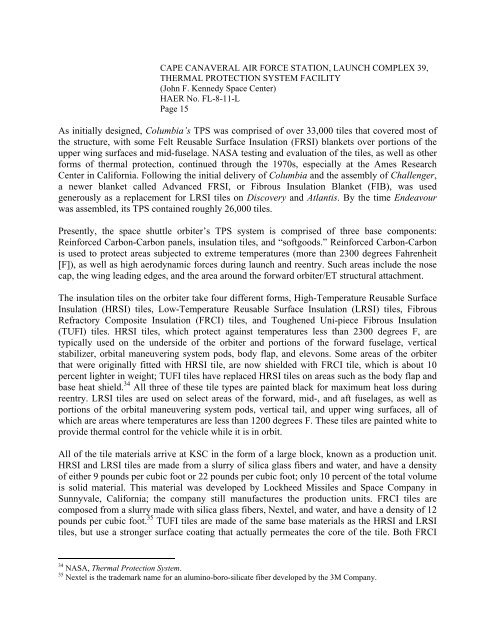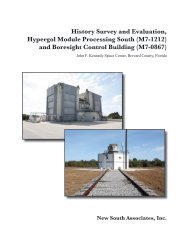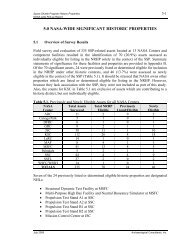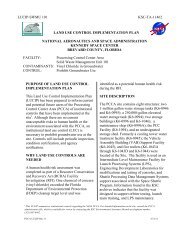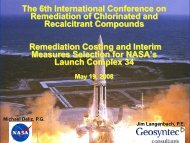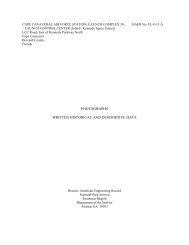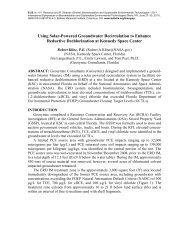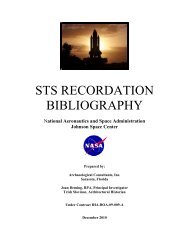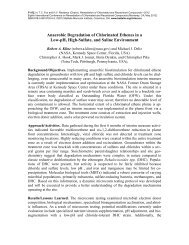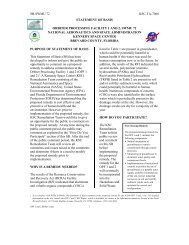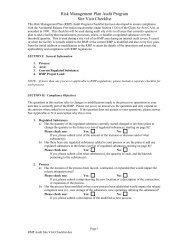Thermal Protection System Facility (TPSF) HAER - Environmental ...
Thermal Protection System Facility (TPSF) HAER - Environmental ...
Thermal Protection System Facility (TPSF) HAER - Environmental ...
You also want an ePaper? Increase the reach of your titles
YUMPU automatically turns print PDFs into web optimized ePapers that Google loves.
CAPE CANAVERAL AIR FORCE STATION, LAUNCH COMPLEX 39,<br />
THERMAL PROTECTION SYSTEM FACILITY<br />
(John F. Kennedy Space Center)<br />
<strong>HAER</strong> No. FL-8-11-L<br />
Page 15<br />
As initially designed, Columbia’s TPS was comprised of over 33,000 tiles that covered most of<br />
the structure, with some Felt Reusable Surface Insulation (FRSI) blankets over portions of the<br />
upper wing surfaces and mid-fuselage. NASA testing and evaluation of the tiles, as well as other<br />
forms of thermal protection, continued through the 1970s, especially at the Ames Research<br />
Center in California. Following the initial delivery of Columbia and the assembly of Challenger,<br />
a newer blanket called Advanced FRSI, or Fibrous Insulation Blanket (FIB), was used<br />
generously as a replacement for LRSI tiles on Discovery and Atlantis. By the time Endeavour<br />
was assembled, its TPS contained roughly 26,000 tiles.<br />
Presently, the space shuttle orbiter’s TPS system is comprised of three base components:<br />
Reinforced Carbon-Carbon panels, insulation tiles, and “softgoods.” Reinforced Carbon-Carbon<br />
is used to protect areas subjected to extreme temperatures (more than 2300 degrees Fahrenheit<br />
[F]), as well as high aerodynamic forces during launch and reentry. Such areas include the nose<br />
cap, the wing leading edges, and the area around the forward orbiter/ET structural attachment.<br />
The insulation tiles on the orbiter take four different forms, High-Temperature Reusable Surface<br />
Insulation (HRSI) tiles, Low-Temperature Reusable Surface Insulation (LRSI) tiles, Fibrous<br />
Refractory Composite Insulation (FRCI) tiles, and Toughened Uni-piece Fibrous Insulation<br />
(TUFI) tiles. HRSI tiles, which protect against temperatures less than 2300 degrees F, are<br />
typically used on the underside of the orbiter and portions of the forward fuselage, vertical<br />
stabilizer, orbital maneuvering system pods, body flap, and elevons. Some areas of the orbiter<br />
that were originally fitted with HRSI tile, are now shielded with FRCI tile, which is about 10<br />
percent lighter in weight; TUFI tiles have replaced HRSI tiles on areas such as the body flap and<br />
base heat shield. 34 All three of these tile types are painted black for maximum heat loss during<br />
reentry. LRSI tiles are used on select areas of the forward, mid-, and aft fuselages, as well as<br />
portions of the orbital maneuvering system pods, vertical tail, and upper wing surfaces, all of<br />
which are areas where temperatures are less than 1200 degrees F. These tiles are painted white to<br />
provide thermal control for the vehicle while it is in orbit.<br />
All of the tile materials arrive at KSC in the form of a large block, known as a production unit.<br />
HRSI and LRSI tiles are made from a slurry of silica glass fibers and water, and have a density<br />
of either 9 pounds per cubic foot or 22 pounds per cubic foot; only 10 percent of the total volume<br />
is solid material. This material was developed by Lockheed Missiles and Space Company in<br />
Sunnyvale, California; the company still manufactures the production units. FRCI tiles are<br />
composed from a slurry made with silica glass fibers, Nextel, and water, and have a density of 12<br />
pounds per cubic foot. 35 TUFI tiles are made of the same base materials as the HRSI and LRSI<br />
tiles, but use a stronger surface coating that actually permeates the core of the tile. Both FRCI<br />
34 NASA, <strong>Thermal</strong> <strong>Protection</strong> <strong>System</strong>.<br />
35 Nextel is the trademark name for an alumino-boro-silicate fiber developed by the 3M Company.


